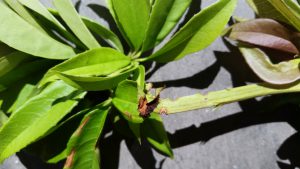Plants can become distorted for a wide variety of reasons. Sometimes nutrient deficiencies or toxicities can cause plants to become distorted. Sometimes excessive amounts of water or sunlight can cause plants to become distorted. And sometimes insect feeding damage can be the culprit.
Insects can cause plant mutations by feeding alone or by vectoring disease from one plant to another. The most recent and most detrimental example of insects vectoring disease is the Asian Citrus Psyllid, which has distributed Huanglongbing, also known as citrus greening, to most of the citrus acreage in Florida and across the United States. Fortunately, the panhandle is currently free from this detrimental disorder. However, we still have a plethora of insects that distort plants by one way or another. One group of plant altering insects are commonly known as planthoppers.
Planthopper adults range in size between 1/8 to 1/4 inches long. They are slender and frequently have an angular, pointed head. Coloration depends on species, but generally planthoppers are of green, brown, or white. Immatures look similar to the adults except they are smaller and don’t have wings. Immatures typically feed on the underside of leaves, where the humidity is higher and they are more protected from predators.
Planthoppers feed on plant leaves and shoots by sucking out the contents. The damage that ensues from feeding depends on the host plant and the hopper species. A few species of hoppers transmit pathogens that can alter plant growth. Usually, adult hoppers are pests only when found in high numbers.
Feeding damage from some species causes small white spots (stippling) to appear on the upper leaf surface, usually beginning near the leaf midrib. Stippled areas eventually merge together into larger whitish blotches. In some plants, feeding damage causes a drying and yellowing (or browning) of leaf tips and some planthopper species cause curling or stunting of newly formed leaves. Oftentimes, white, papery skin castings will remain from the molting process on the undersides of leaves.
Planthoppers are rarely present in large enough numbers to cause significant plant damage. Fortunately, planthoppers have many natural enemies including lady beetles, lacewings, damsel bugs, and spiders. Sticky traps are recommended to help monitor planthopper populations. Planthoppers are usually attracted to yellow sticky traps that can be placed among the plant leaves. Small populations can be managed using these traps. If greater populations are present, then insecticidal soap can control young planthoppers. Make sure to spray both the top and underside of the leaves.
Planthoppers are minor pests in the landscape, but they can cause alarming mutations in plant material. Contact your local Extension Office for help with diagnosis and treatment options.
- Is a Limequat a Lime or a Kumquat? - December 26, 2025
- Gardening in the Panhandle LIVE! Program Summary: Pests of Florida Lawns and Landscape Plants - May 28, 2025
- Fun Facts About Ferns - April 30, 2025


